L8 Animal Sensory Systems
1/38
Earn XP
Name | Mastery | Learn | Test | Matching | Spaced |
|---|
No study sessions yet.
39 Terms
Chemoreception
A chemical ligand triggers receptor, causing signal transduction
How an organism detects and responds to chemical stimuli
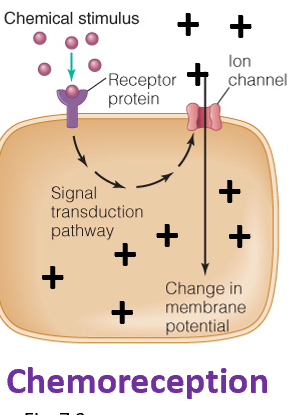
Mechanoreception
Stretch waves includes hearing (hair cells bend to pressure of incoming sound waves)
The process of detecting mechanical stimuli such as pressure, touch, and sound through specialized receptors
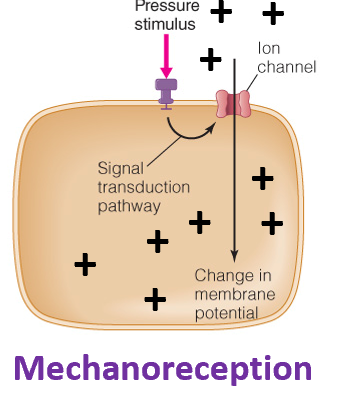
Photoreception
A photon strikes a receptor, which induces an ion cannel to open
how an organism detects and responds to light

Polymodal sensilla
complex organs that contain both mechano- and chemoreceptors for feeling and tasting their environment
insect antennae
Can insects detect water and ammonia
yes
what do insects detect?
What is olfaction
sense of smell which allows an organism to smell odors
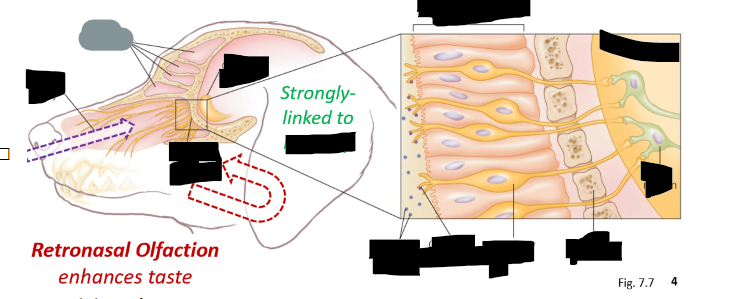
Label
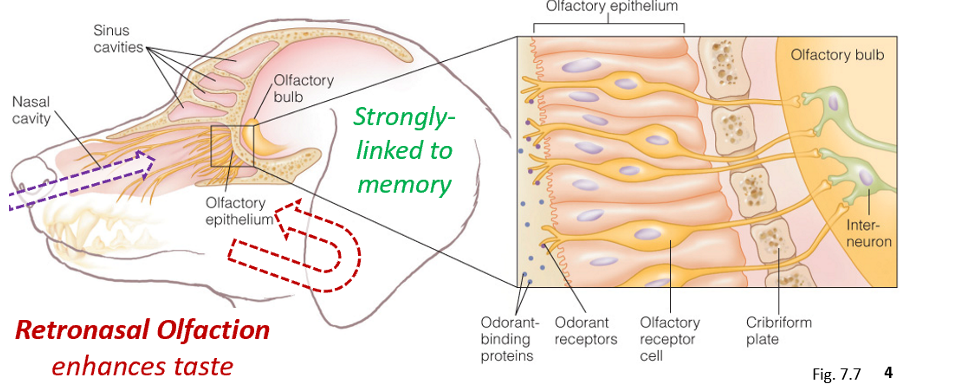
Retronasal
breathing through the mouth
The odorants curve up into your nasal sinus
Thus, when your nose is clogged you cant smell as good
Olfactory epithelium
odorants enter the nasal cavity and adhere to mucosa in the olfactory epithelium
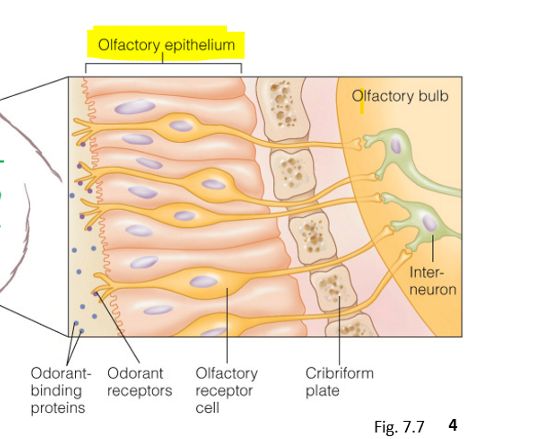
Olfactory bulb
Bipolar sensory neurons penetrate the braincase to the olfactory bulb

Olfactory pathway
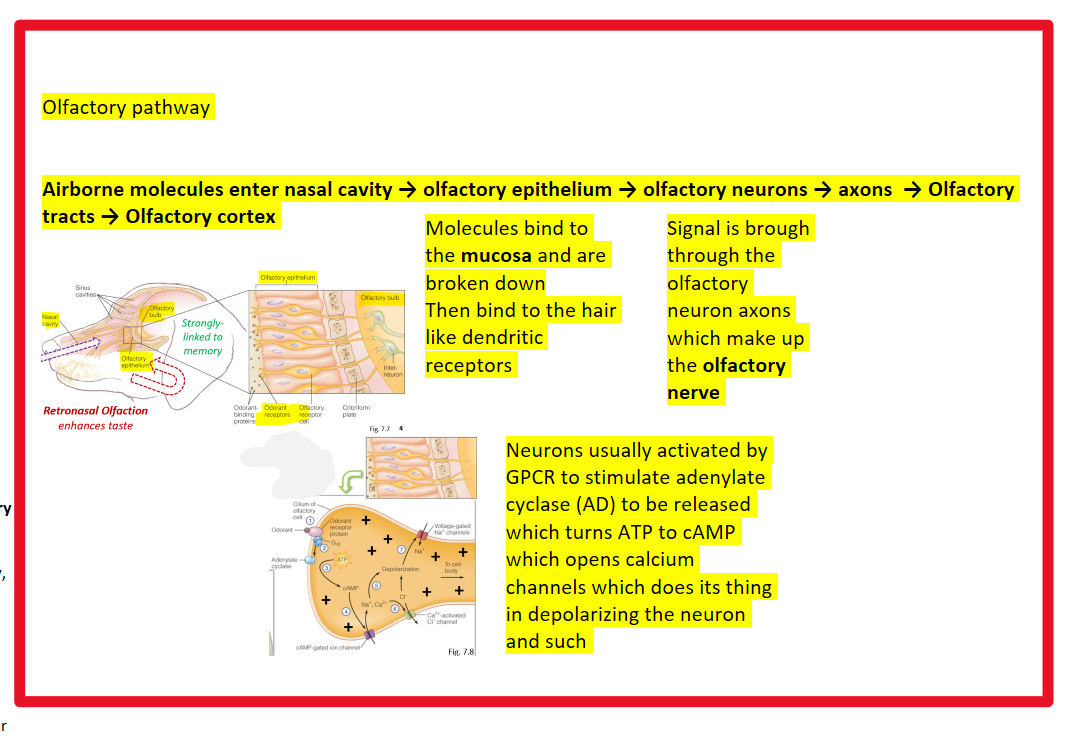
Why are olfactory receptor neurons (ORN) called bipolar?
Bc morphologically their cell body is the middle of the cell, but they still transmit APs (action potentials) one way to the olfactory bulb
orthonasal olfaction
breathing through the nostrils
Watery mucosa
Enhances smelling by trapping odorants which allows them to bind to an odor receptor more easily
Olfaction in fish
Water passes through their nares (allows for always fresh sampling)
This leads to olfactory epithelium in the olfactory rosette
Sharks have a lamellae which is similar to a rosette

positive chemotaxis
Going toward stimulus
negative chemotaxis
Going away from stimulus
Pheromones — how works / purposes
AKA chemoattractant
Signal only sent within the same species
Helpful for finding a mate, immediate relative, ones offspring, territories, other animals rank or sec
Chemosensory sensilla
small hairlike sensory organs that detect chemical stimuli
Activation of salty TRCs
sodium directly enters Na+ channel from the salt which opens voltage gated Ca+ channels, leading to depolarization and NTM (antagonistic signaling molecules) release
Activation of Sour TRCs
protons from acidity blocks potassium channel, which prevents K+ efflux, depolarizing the cell
This opens the VG-Ca+ channels, leading to NTM release
Protons inhibit potassium channels
Activation of sweet TRCs
Sweet substance binds to GPCR, which activates adanylate cycase to cAMP which inhibits K+ channel which depolarizes the neuron and causes NTM release
Different GCPR activated → Ca+ influx
Activation of bitter or umami TRCs
different GPCRs are activated
Why do some ppl have different flavor preferances or aversions?
bc we have different populations of GPCR heterodimers in our taste receptor cells
Some ppl are more sensitive/insensitive to certain tastants depending on the density and type of taste receptors
Thermoreception
Detection of heat
Pit vipers use this to find prey in the night
TRPs (transient receptor potential) open in response to heat
Differential heat detection in left or right side of organisms head will tell them the direction of their prey
TRPs
transient receptor potentials
A1 channels
line the membrane of pit organs
What are pit organs + 2 animals that have them
pit viper (located in their face and look like nostrils) and bats (located left, right, and above their nostrils)
these are indentations on the face which detect heat — it may be like seeing bc this information is sent to the optic tectum in the brain
Pit viper uses them to sense where a prey is and vampire bats use them to sense where a spot with a lot of blood is on an animal
Nociception
Sense of harm/pain
Proprioception
Sense of awareness of the position of one’s body parts in space
Chondrichthyes
Cartilaginous fish
Who usually has electroreception
Chondrichthyes — cartilaginous fish
What are the electro sensors called in sharks? other info?
Ampullae of Lorenzini (AoL)
they detect weak electromagnetic fields + maybe touch and temp
They go deep into the dermis and open to the water through a large pore
A conductive gel fills the canal from the external surface pore to the ampullae —- in this is keratin sulfate (the highest conductivity known for biological material)

Are the AoL (Ampullae of Lorenzini) in sharks considered an active or passive form of electrolocation?
Passive
The 3 steps of active electrolocation
discharge from caudal electric organ
Detection in dermal sensors
Interpretation in the brain
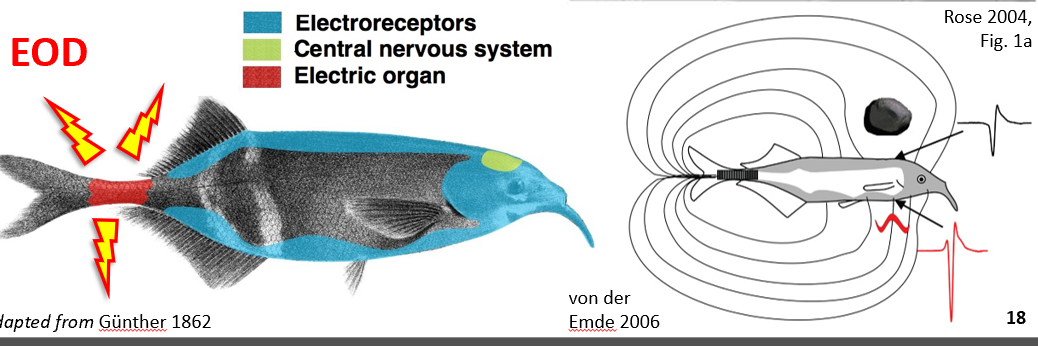
How is electrolocation in elephantnose fishes is benificial in this species? Where is the signal dispersed from their body? Is this passive or active?
Their electric wave they create around them is distorted when their is something in it like a rock/worm, and thus they can detect it in the dark
dermal electroreceptors
active

EOD
Electric organ discharge
Electrical communication for JAR
JAR = Jamming avoidance response
When species in close vicinity that both use electrolocation will dim their frequency or go up a few Hertz in order to not interfere with their signals
evidence for independent evolution of electric organs in fish? How do they differ between taxa?
active electrolocation and communication evolved independently in two taxonomic orders
Africa and in South America
New world (south america) knifefishes and electric eels emit waves
Old world fishes (africa) elephantfish emit pulses (lower trace)
Differences in EODs are explained by mutations in the VG-Na+ channels

Gustation
Tasting